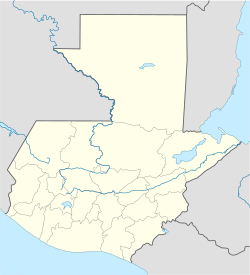Senahú facts for kids
Quick facts for kids
Senahú
|
|
|---|---|
|
Municipality
|
|
| Country | |
| Department | |
| Municipality | Senahú |
| Government | |
| • Type | Municipal |
| Area | |
| • Municipality | 736 km2 (284 sq mi) |
| Elevation | 970 m (3,180 ft) |
| Population
(Census 2018)
|
|
| • Municipality | 91,974 |
| • Density | 124.96/km2 (323.66/sq mi) |
| • Urban | 12,084 |
| • Ethnicities | Q'eqchi' Ladino |
| • Religions | Roman Catholicism Evangelicalism Maya |
| Climate | Af |
Senahú is a town and a municipality located in the Alta Verapaz Department in Guatemala. It is a vibrant community with a rich history and beautiful natural surroundings.
The area of Senahú is about 736 square kilometers (284 square miles). In 2018, its population was 91,974 people. The municipality includes one main town and 41 smaller communities.
Senahú is surrounded by other municipalities. To the north are Cahabón and Lanquín. To the south are Panzós and Tucurú. To the east is El Estor in the Izabal Department. To the west are Tucurú and San Pedro Carchá.
Contents
History of Senahú
The community of San Antonio Senahú was started by Q'eqchi' Mayan people. They were refugees from conflicts in the Ishi Mountains during the 1800s.
By the mid-1870s, Senahú became a place where many German settlers lived in Guatemala. It also became a major source of coffee for countries in Europe.
Economy and Natural Resources
The main source of money for the region still comes from large coffee farms. Other farm products are also important.
Senahú has many natural treasures. These include the river of the "Trece Aguas" farm and the Sereizi waterfalls. There is also a great viewpoint at the general cemetery.
Famous Places and Crafts
Two other well-known spots in Senahú are the ruins of Chijolom and La Providencia. These places hold interesting history.
The people of Senahú are skilled at making many crafts. These include woven items, ceramics, and basketwork. They also make musical instruments, masks, and fireworks.
Languages Spoken
The main languages spoken in Senahú are the Mayan language Q'eqchi' and Spanish.
Important Dates for Senahú
- March 13, 1869 – Senahú officially became a municipality by a special government agreement.
Celebrations in Senahú
Every year, from June 8th to 13th, Senahú celebrates its patron saint, San Antonio.
Also, at the end of August each year, there is a festival for San Antonio de Padua. This festival celebrates the local native peoples. A special part of the festivities is a beauty contest for Q'eqchi' Maya women. The winner is crowned with the title "Miss Senahuk".
Northern Transversal Strip
Lua error in Module:Location_map at line 420: attempt to index field 'wikibase' (a nil value). The Northern Transversal Strip (known as Franja Transversal del Norte in Spanish) is an area in Guatemala. It was created in 1970 to help with farming development.
A law was passed that said it was important for the country to develop farms in this area. This strip includes Senahú and many other municipalities across several departments.
Climate in Senahú
Senahú has a tropical climate. This means it is warm all year round and gets a lot of rain. It is classified as a tropical rainforest climate (Af) by the Köppen climate classification.
| Climate data for Senahú | |||||||||||||
|---|---|---|---|---|---|---|---|---|---|---|---|---|---|
| Month | Jan | Feb | Mar | Apr | May | Jun | Jul | Aug | Sep | Oct | Nov | Dec | Year |
| Daily mean °C (°F) | 19.3 (66.7) |
20.3 (68.5) |
21.6 (70.9) |
22.8 (73.0) |
23.2 (73.8) |
23.0 (73.4) |
22.6 (72.7) |
22.7 (72.9) |
22.7 (72.9) |
21.7 (71.1) |
20.6 (69.1) |
19.8 (67.6) |
21.7 (71.1) |
| Average precipitation mm (inches) | 141 (5.6) |
110 (4.3) |
106 (4.2) |
142 (5.6) |
313 (12.3) |
621 (24.4) |
691 (27.2) |
546 (21.5) |
535 (21.1) |
395 (15.6) |
207 (8.1) |
138 (5.4) |
3,945 (155.3) |
| Source: Climate-Data.org | |||||||||||||
Geographic Location
 |
Cahabón and Lanquín, Alta Verapaz Department municipalities |  |
||
| Tucurú and San Pedro Carchá, Alta Verapaz Department municipalities | El Estor, Izabal Department municipality | |||
| Panzós and Tucurú, Alta Verapaz Department municipalities |
See also
 In Spanish: Senahú para niños
In Spanish: Senahú para niños


